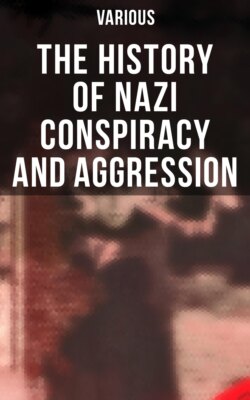Читать книгу The History of Nazi Conspiracy and Aggression - Various - Страница 6
На сайте Литреса книга снята с продажи.
I
ОглавлениеOn the 2d day of May 1945, President Truman signed Executive Order 9547 appointing Justice Robert H. Jackson as Representative of the United States and as its Chief of Counsel in the preparation and prosecution of the case against the major Axis war criminals. Since that date and up to the present, the staff of the Office of Chief of Counsel, or OCC, has been engaged continuously in the discovery, collection, examination, translation, and marshalling of documentary evidence demonstrating the criminality of the former leaders of the German Reich. Since the 20th day of November 1945, a considerable part of this documentary arsenal has been directed against the 22 major Nazi war criminals who are on trial before the International Military Tribunal in Nurnberg. As of this writing the American and British cases-in-chief, on Counts I and II of the Indictment charging, respectively, conspiracy and the waging of wars of aggression, have been completed.
There is perhaps no need to recall in these pages that the Nurnberg trial represents the first time in history that legal proceedings have been instituted against leaders of an enemy nation. It is perhaps equal supererogation to state here that there are no exact precedents for the charges made by the American, British, French, and Russian prosecutors that to plot or wage a war of aggression is a crime for which individuals may be punished. Yet it was because of these very facts that in its indictment the prosecution presented a challenge to itself quite as great as to the defense. A heavy burden was laid on the accusing nations to make sure that their proof measured up to the magnitude of their accusations, and that the daring of their grand conception was matched by the industry of their research, lest the hard-bought opportunity to make International Law a guardian of peace should fail by default.
It is not surprising, therefore, that the American collecting and processing of documentary evidence, under the general direction of Col. Robert G. Storey, gradually developed into an operation of formidable scope. Although some pieces of evidence were secured in Washington and London, by far the greater part was obtained in the land of the enemy. As the American Armies had swept into Germany, military investigating teams had filled document centers with an increasing wealth of materials which were freely made available by the Army to OCC field investigators. Special assistance was given by the Document Section, G-2 Division, SHAEF, and by the Document Sections of the Army Groups and Armies operating in the European Theater. OCC investigators also made valuable discoveries while prospecting on their own. They soon found themselves embarrassed with riches. Perhaps foremost among the prize acquisitions was the neatly crated collection of all the personal and official correspondence of Alfred Rosenberg, together with a great quantity of Nazi Party correspondence. This cache was discovered behind a false wall in an old castle in Eastern Bavaria, where it had been sent for safekeeping. Another outstanding collection consisted of thirty-nine leather-bound volumes containing detailed inventories of the art treasures of Europe which had been looted by the Einsatzstab Rosenberg. These catalogues, together with much of the priceless plunder itself, were found hidden deep in an Austrian salt mine. An innocent-appearing castle near Marburg was found to contain some 485 tons of crated papers, which inspection revealed to be the records of the German Foreign Office from 1837 to 1944. Among other outstanding bulk acquisitions were more than 300 crates of German High Command files, 85 notebooks containing minutes of Hitler’s conferences, and the complete files of the German Navy.
The task was to screen thoroughly this abundance of material so as to overlook no relevant item, and yet at the same time to obtain the proof and to translate it in season, so as not to delay preparation of the Indictment or commencement of the trial. The procedures followed in this process are described in the affidavit of Maj. William H. Coogan (001-A-PS), which is listed numerically among the documents. As a result of those procedures, more than 100,000 documents were individually examined in order to segregate those of importance. Of these 100,000 documents, approximately 4,000 were found to be of clear or potential value. This group of 4,000 was further reduced through exacting standards of elimination to a total of some 2,000 documents which it was proposed to offer in evidence, and which make up the bulk of this publication. Thus, the documents presented in these volumes are the fittest survivors of a rigorous sifting. Each of them has met requirements designed to ensure the selection of only the most significant in bearing on the American case. Documents primarily concerned with the report of individual barbarities or perversions were excluded, in conformity with the emphasis placed upon those tending to prove elements in the Nazi Master Plan.
These documents consist, in the main, of official papers found in archives of the German Government and Nazi Party, diaries and letters of prominent Germans, and captured reports and orders. There are included, in addition, excerpts from governmental and Party decrees, from official newspapers and from authoritative German publications. The authenticity of all these materials is established by Maj. Coogan’s affidavit (001-A-PS). Considered together, they reveal a fairly comprehensive view of the inner workings and outward deeds of the German government and of the Nazi Party, which were always concealed from the world, and for which, the world will always hold the Hitler regime in horror and contempt.
